Taxation Law Assignment: Brekkie and Lunch, OZ Bottle Shop Tax Return
VerifiedAdded on 2023/04/20
|10
|2114
|297
Homework Assignment
AI Summary
This assignment solution addresses a taxation law problem concerning Daniel and Olivia Smith's mixed business, Brekkie and Lunch and OZ Bottle Shop. The solution analyzes the partnership's net income calculation, considering business sales, debtor payments, and various expenses, including depreciation, repairs, and loan repayments. It references relevant sections of the ITAA 1936 and ITAA 1997, as well as ATO guidelines. The solution also covers fringe benefits tax (FBT), specifically addressing expense payment and accommodation fringe benefits provided to an employee, John. The analysis considers the tax implications of school fees paid for John's child and the market value of an apartment provided to John, referencing the FBTAA 1986 and relevant case law, such as J & G Knowles v Federal Commissioner of Taxation (2000).
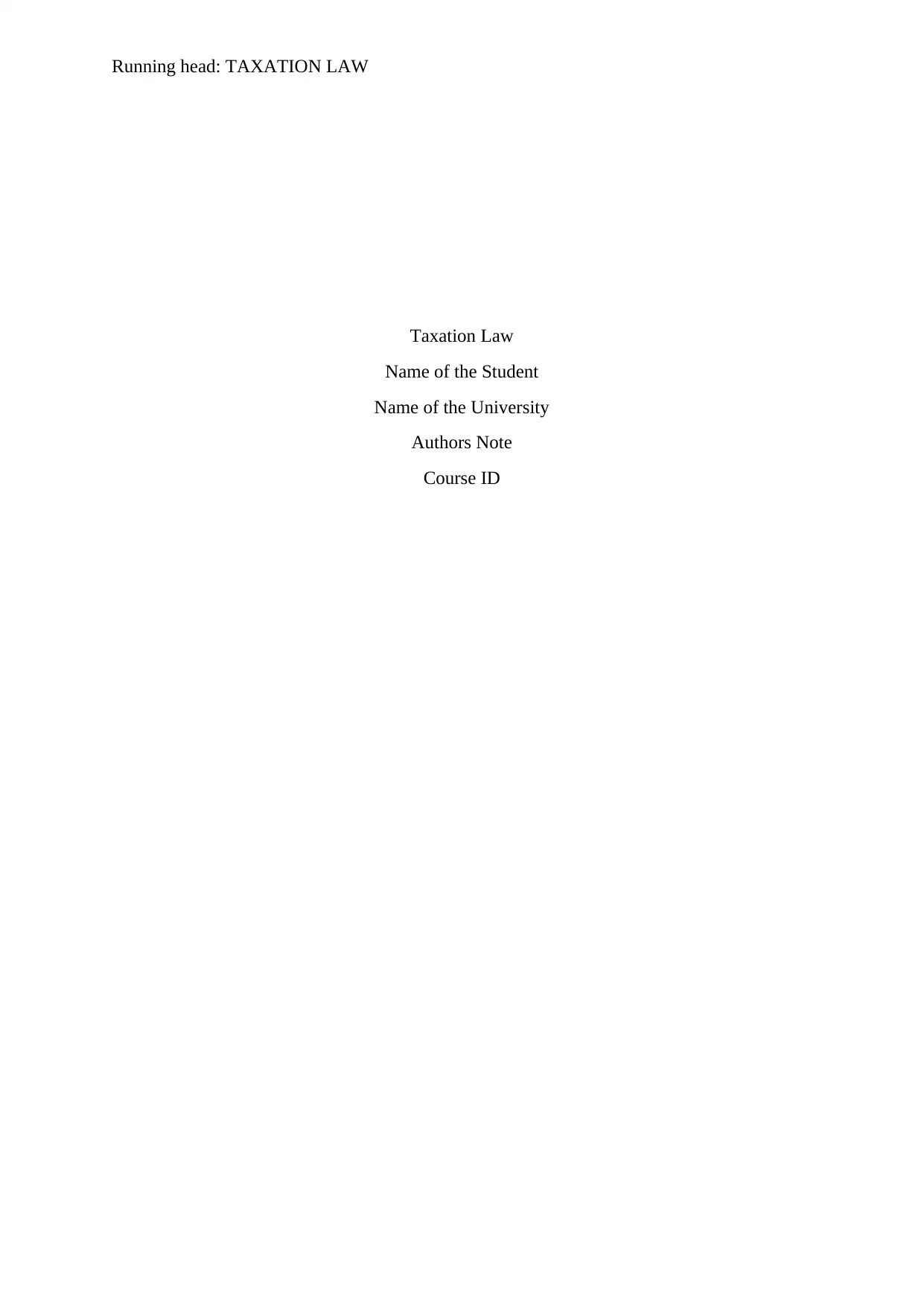
Running head: TAXATION LAW
Taxation Law
Name of the Student
Name of the University
Authors Note
Course ID
Taxation Law
Name of the Student
Name of the University
Authors Note
Course ID
Paraphrase This Document
Need a fresh take? Get an instant paraphrase of this document with our AI Paraphraser
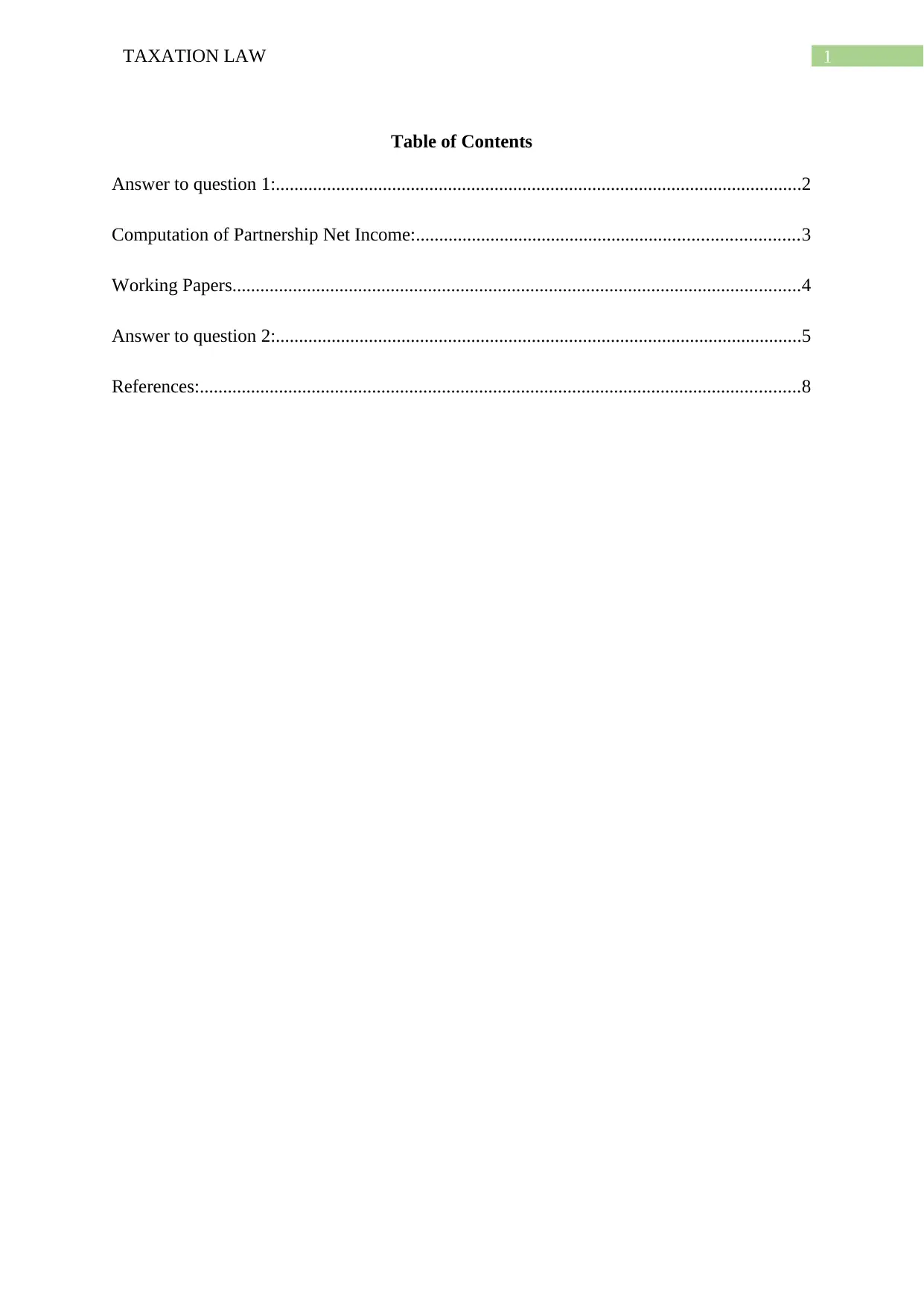
1TAXATION LAW
Table of Contents
Answer to question 1:.................................................................................................................2
Computation of Partnership Net Income:..................................................................................3
Working Papers..........................................................................................................................4
Answer to question 2:.................................................................................................................5
References:.................................................................................................................................8
Table of Contents
Answer to question 1:.................................................................................................................2
Computation of Partnership Net Income:..................................................................................3
Working Papers..........................................................................................................................4
Answer to question 2:.................................................................................................................5
References:.................................................................................................................................8
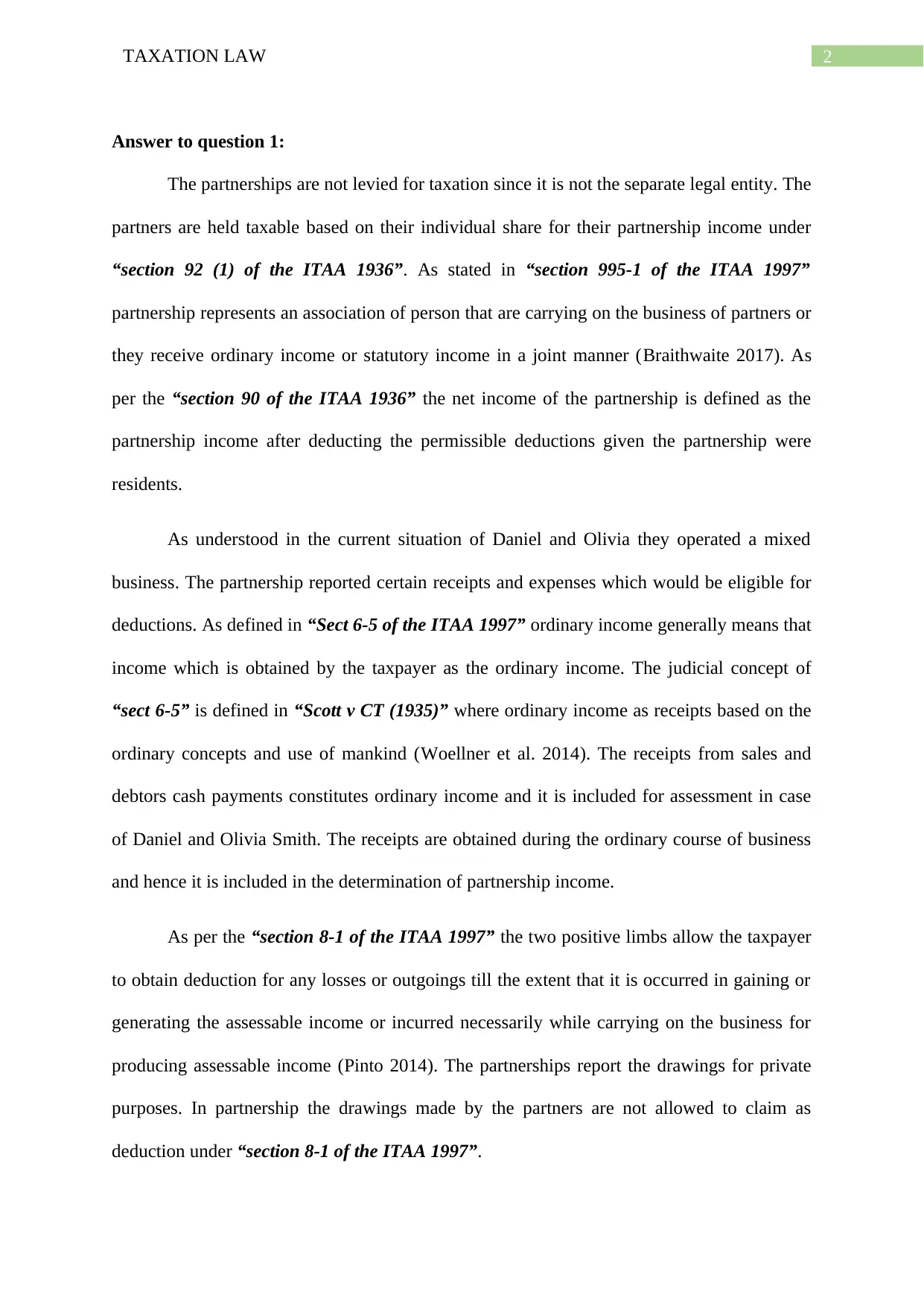
2TAXATION LAW
Answer to question 1:
The partnerships are not levied for taxation since it is not the separate legal entity. The
partners are held taxable based on their individual share for their partnership income under
“section 92 (1) of the ITAA 1936”. As stated in “section 995-1 of the ITAA 1997”
partnership represents an association of person that are carrying on the business of partners or
they receive ordinary income or statutory income in a joint manner (Braithwaite 2017). As
per the “section 90 of the ITAA 1936” the net income of the partnership is defined as the
partnership income after deducting the permissible deductions given the partnership were
residents.
As understood in the current situation of Daniel and Olivia they operated a mixed
business. The partnership reported certain receipts and expenses which would be eligible for
deductions. As defined in “Sect 6-5 of the ITAA 1997” ordinary income generally means that
income which is obtained by the taxpayer as the ordinary income. The judicial concept of
“sect 6-5” is defined in “Scott v CT (1935)” where ordinary income as receipts based on the
ordinary concepts and use of mankind (Woellner et al. 2014). The receipts from sales and
debtors cash payments constitutes ordinary income and it is included for assessment in case
of Daniel and Olivia Smith. The receipts are obtained during the ordinary course of business
and hence it is included in the determination of partnership income.
As per the “section 8-1 of the ITAA 1997” the two positive limbs allow the taxpayer
to obtain deduction for any losses or outgoings till the extent that it is occurred in gaining or
generating the assessable income or incurred necessarily while carrying on the business for
producing assessable income (Pinto 2014). The partnerships report the drawings for private
purposes. In partnership the drawings made by the partners are not allowed to claim as
deduction under “section 8-1 of the ITAA 1997”.
Answer to question 1:
The partnerships are not levied for taxation since it is not the separate legal entity. The
partners are held taxable based on their individual share for their partnership income under
“section 92 (1) of the ITAA 1936”. As stated in “section 995-1 of the ITAA 1997”
partnership represents an association of person that are carrying on the business of partners or
they receive ordinary income or statutory income in a joint manner (Braithwaite 2017). As
per the “section 90 of the ITAA 1936” the net income of the partnership is defined as the
partnership income after deducting the permissible deductions given the partnership were
residents.
As understood in the current situation of Daniel and Olivia they operated a mixed
business. The partnership reported certain receipts and expenses which would be eligible for
deductions. As defined in “Sect 6-5 of the ITAA 1997” ordinary income generally means that
income which is obtained by the taxpayer as the ordinary income. The judicial concept of
“sect 6-5” is defined in “Scott v CT (1935)” where ordinary income as receipts based on the
ordinary concepts and use of mankind (Woellner et al. 2014). The receipts from sales and
debtors cash payments constitutes ordinary income and it is included for assessment in case
of Daniel and Olivia Smith. The receipts are obtained during the ordinary course of business
and hence it is included in the determination of partnership income.
As per the “section 8-1 of the ITAA 1997” the two positive limbs allow the taxpayer
to obtain deduction for any losses or outgoings till the extent that it is occurred in gaining or
generating the assessable income or incurred necessarily while carrying on the business for
producing assessable income (Pinto 2014). The partnerships report the drawings for private
purposes. In partnership the drawings made by the partners are not allowed to claim as
deduction under “section 8-1 of the ITAA 1997”.
⊘ This is a preview!⊘
Do you want full access?
Subscribe today to unlock all pages.

Trusted by 1+ million students worldwide
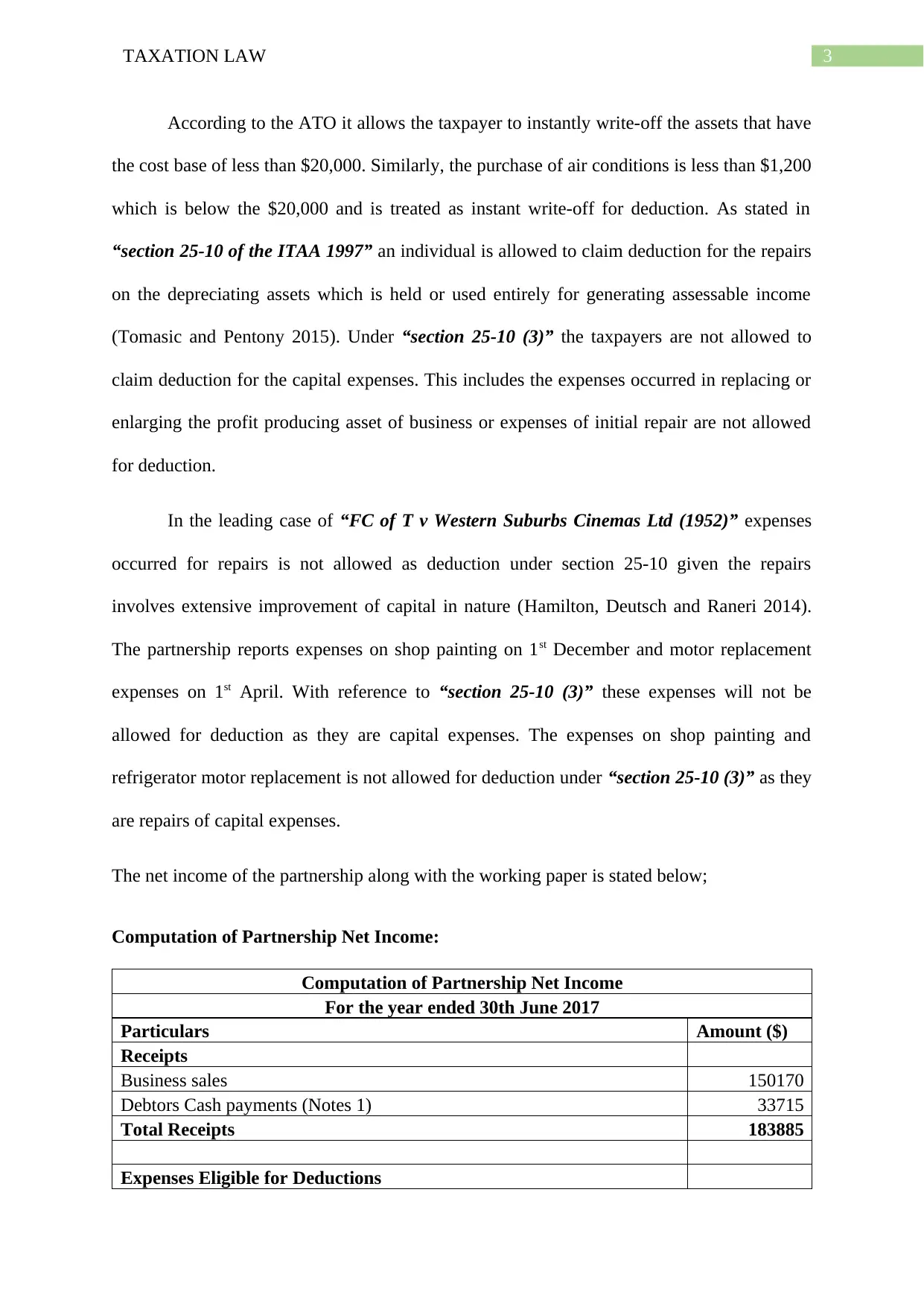
3TAXATION LAW
According to the ATO it allows the taxpayer to instantly write-off the assets that have
the cost base of less than $20,000. Similarly, the purchase of air conditions is less than $1,200
which is below the $20,000 and is treated as instant write-off for deduction. As stated in
“section 25-10 of the ITAA 1997” an individual is allowed to claim deduction for the repairs
on the depreciating assets which is held or used entirely for generating assessable income
(Tomasic and Pentony 2015). Under “section 25-10 (3)” the taxpayers are not allowed to
claim deduction for the capital expenses. This includes the expenses occurred in replacing or
enlarging the profit producing asset of business or expenses of initial repair are not allowed
for deduction.
In the leading case of “FC of T v Western Suburbs Cinemas Ltd (1952)” expenses
occurred for repairs is not allowed as deduction under section 25-10 given the repairs
involves extensive improvement of capital in nature (Hamilton, Deutsch and Raneri 2014).
The partnership reports expenses on shop painting on 1st December and motor replacement
expenses on 1st April. With reference to “section 25-10 (3)” these expenses will not be
allowed for deduction as they are capital expenses. The expenses on shop painting and
refrigerator motor replacement is not allowed for deduction under “section 25-10 (3)” as they
are repairs of capital expenses.
The net income of the partnership along with the working paper is stated below;
Computation of Partnership Net Income:
Computation of Partnership Net Income
For the year ended 30th June 2017
Particulars Amount ($)
Receipts
Business sales 150170
Debtors Cash payments (Notes 1) 33715
Total Receipts 183885
Expenses Eligible for Deductions
According to the ATO it allows the taxpayer to instantly write-off the assets that have
the cost base of less than $20,000. Similarly, the purchase of air conditions is less than $1,200
which is below the $20,000 and is treated as instant write-off for deduction. As stated in
“section 25-10 of the ITAA 1997” an individual is allowed to claim deduction for the repairs
on the depreciating assets which is held or used entirely for generating assessable income
(Tomasic and Pentony 2015). Under “section 25-10 (3)” the taxpayers are not allowed to
claim deduction for the capital expenses. This includes the expenses occurred in replacing or
enlarging the profit producing asset of business or expenses of initial repair are not allowed
for deduction.
In the leading case of “FC of T v Western Suburbs Cinemas Ltd (1952)” expenses
occurred for repairs is not allowed as deduction under section 25-10 given the repairs
involves extensive improvement of capital in nature (Hamilton, Deutsch and Raneri 2014).
The partnership reports expenses on shop painting on 1st December and motor replacement
expenses on 1st April. With reference to “section 25-10 (3)” these expenses will not be
allowed for deduction as they are capital expenses. The expenses on shop painting and
refrigerator motor replacement is not allowed for deduction under “section 25-10 (3)” as they
are repairs of capital expenses.
The net income of the partnership along with the working paper is stated below;
Computation of Partnership Net Income:
Computation of Partnership Net Income
For the year ended 30th June 2017
Particulars Amount ($)
Receipts
Business sales 150170
Debtors Cash payments (Notes 1) 33715
Total Receipts 183885
Expenses Eligible for Deductions
Paraphrase This Document
Need a fresh take? Get an instant paraphrase of this document with our AI Paraphraser
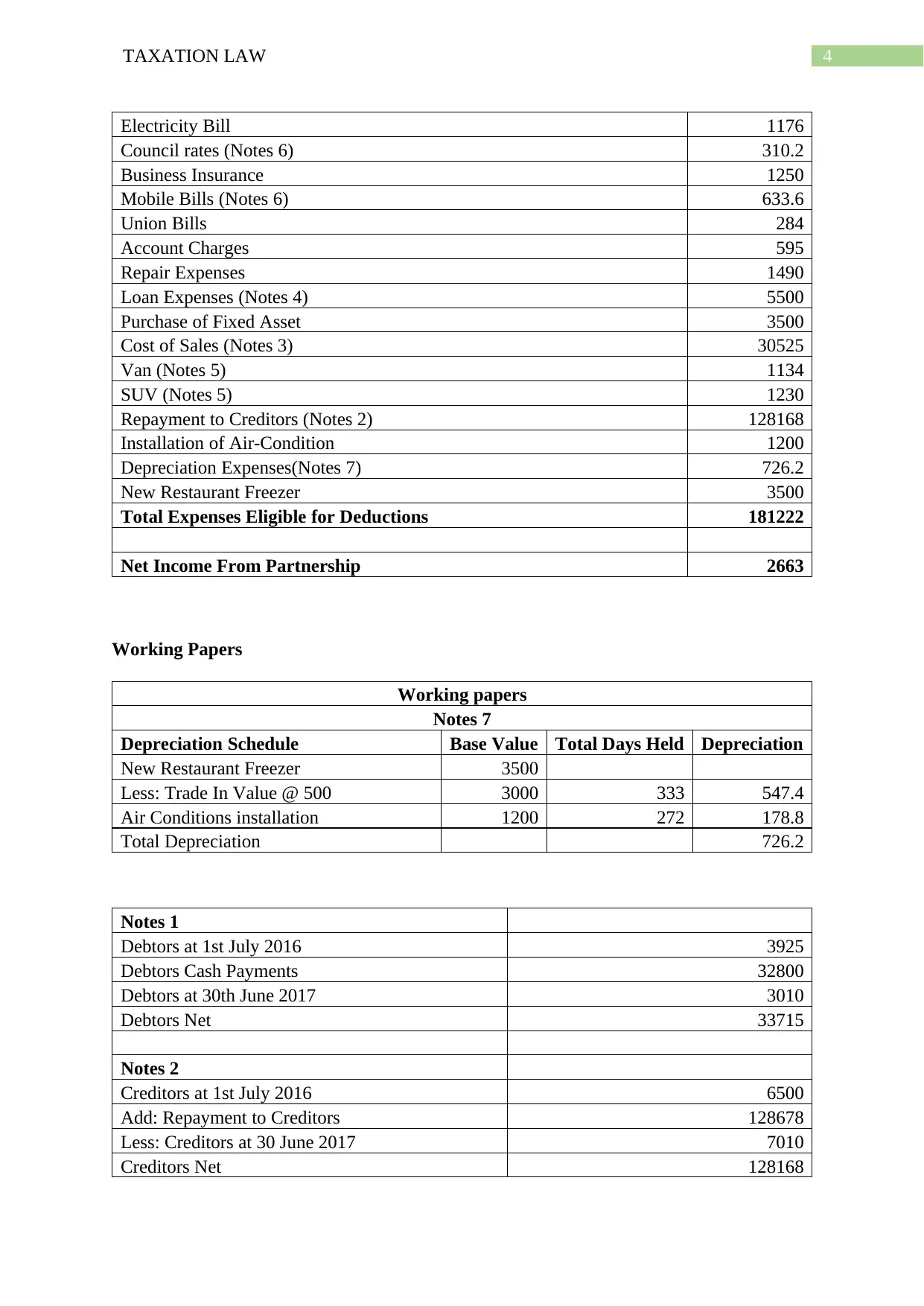
4TAXATION LAW
Electricity Bill 1176
Council rates (Notes 6) 310.2
Business Insurance 1250
Mobile Bills (Notes 6) 633.6
Union Bills 284
Account Charges 595
Repair Expenses 1490
Loan Expenses (Notes 4) 5500
Purchase of Fixed Asset 3500
Cost of Sales (Notes 3) 30525
Van (Notes 5) 1134
SUV (Notes 5) 1230
Repayment to Creditors (Notes 2) 128168
Installation of Air-Condition 1200
Depreciation Expenses(Notes 7) 726.2
New Restaurant Freezer 3500
Total Expenses Eligible for Deductions 181222
Net Income From Partnership 2663
Working Papers
Working papers
Notes 7
Depreciation Schedule Base Value Total Days Held Depreciation
New Restaurant Freezer 3500
Less: Trade In Value @ 500 3000 333 547.4
Air Conditions installation 1200 272 178.8
Total Depreciation 726.2
Notes 1
Debtors at 1st July 2016 3925
Debtors Cash Payments 32800
Debtors at 30th June 2017 3010
Debtors Net 33715
Notes 2
Creditors at 1st July 2016 6500
Add: Repayment to Creditors 128678
Less: Creditors at 30 June 2017 7010
Creditors Net 128168
Electricity Bill 1176
Council rates (Notes 6) 310.2
Business Insurance 1250
Mobile Bills (Notes 6) 633.6
Union Bills 284
Account Charges 595
Repair Expenses 1490
Loan Expenses (Notes 4) 5500
Purchase of Fixed Asset 3500
Cost of Sales (Notes 3) 30525
Van (Notes 5) 1134
SUV (Notes 5) 1230
Repayment to Creditors (Notes 2) 128168
Installation of Air-Condition 1200
Depreciation Expenses(Notes 7) 726.2
New Restaurant Freezer 3500
Total Expenses Eligible for Deductions 181222
Net Income From Partnership 2663
Working Papers
Working papers
Notes 7
Depreciation Schedule Base Value Total Days Held Depreciation
New Restaurant Freezer 3500
Less: Trade In Value @ 500 3000 333 547.4
Air Conditions installation 1200 272 178.8
Total Depreciation 726.2
Notes 1
Debtors at 1st July 2016 3925
Debtors Cash Payments 32800
Debtors at 30th June 2017 3010
Debtors Net 33715
Notes 2
Creditors at 1st July 2016 6500
Add: Repayment to Creditors 128678
Less: Creditors at 30 June 2017 7010
Creditors Net 128168
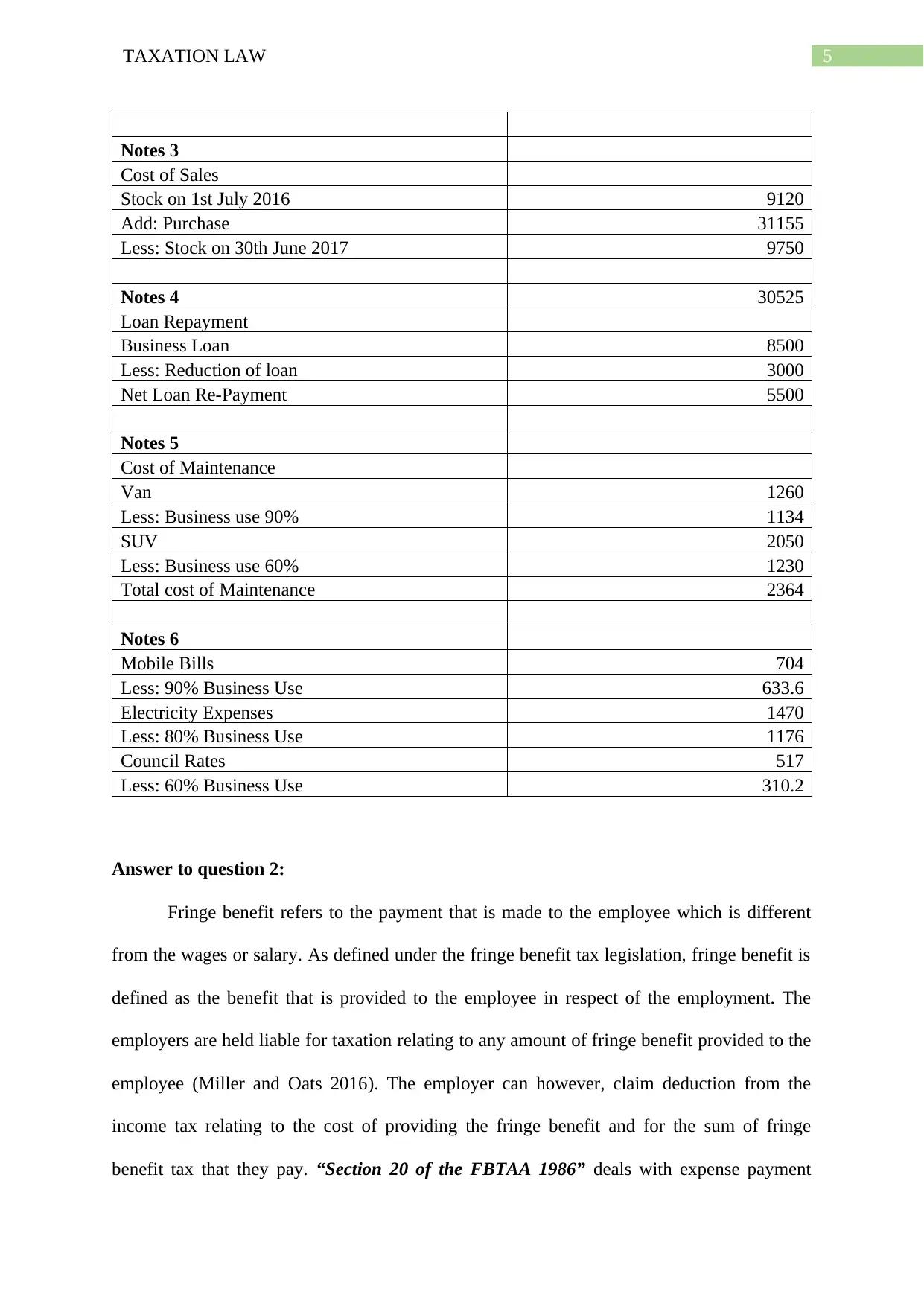
5TAXATION LAW
Notes 3
Cost of Sales
Stock on 1st July 2016 9120
Add: Purchase 31155
Less: Stock on 30th June 2017 9750
Notes 4 30525
Loan Repayment
Business Loan 8500
Less: Reduction of loan 3000
Net Loan Re-Payment 5500
Notes 5
Cost of Maintenance
Van 1260
Less: Business use 90% 1134
SUV 2050
Less: Business use 60% 1230
Total cost of Maintenance 2364
Notes 6
Mobile Bills 704
Less: 90% Business Use 633.6
Electricity Expenses 1470
Less: 80% Business Use 1176
Council Rates 517
Less: 60% Business Use 310.2
Answer to question 2:
Fringe benefit refers to the payment that is made to the employee which is different
from the wages or salary. As defined under the fringe benefit tax legislation, fringe benefit is
defined as the benefit that is provided to the employee in respect of the employment. The
employers are held liable for taxation relating to any amount of fringe benefit provided to the
employee (Miller and Oats 2016). The employer can however, claim deduction from the
income tax relating to the cost of providing the fringe benefit and for the sum of fringe
benefit tax that they pay. “Section 20 of the FBTAA 1986” deals with expense payment
Notes 3
Cost of Sales
Stock on 1st July 2016 9120
Add: Purchase 31155
Less: Stock on 30th June 2017 9750
Notes 4 30525
Loan Repayment
Business Loan 8500
Less: Reduction of loan 3000
Net Loan Re-Payment 5500
Notes 5
Cost of Maintenance
Van 1260
Less: Business use 90% 1134
SUV 2050
Less: Business use 60% 1230
Total cost of Maintenance 2364
Notes 6
Mobile Bills 704
Less: 90% Business Use 633.6
Electricity Expenses 1470
Less: 80% Business Use 1176
Council Rates 517
Less: 60% Business Use 310.2
Answer to question 2:
Fringe benefit refers to the payment that is made to the employee which is different
from the wages or salary. As defined under the fringe benefit tax legislation, fringe benefit is
defined as the benefit that is provided to the employee in respect of the employment. The
employers are held liable for taxation relating to any amount of fringe benefit provided to the
employee (Miller and Oats 2016). The employer can however, claim deduction from the
income tax relating to the cost of providing the fringe benefit and for the sum of fringe
benefit tax that they pay. “Section 20 of the FBTAA 1986” deals with expense payment
⊘ This is a preview!⊘
Do you want full access?
Subscribe today to unlock all pages.

Trusted by 1+ million students worldwide
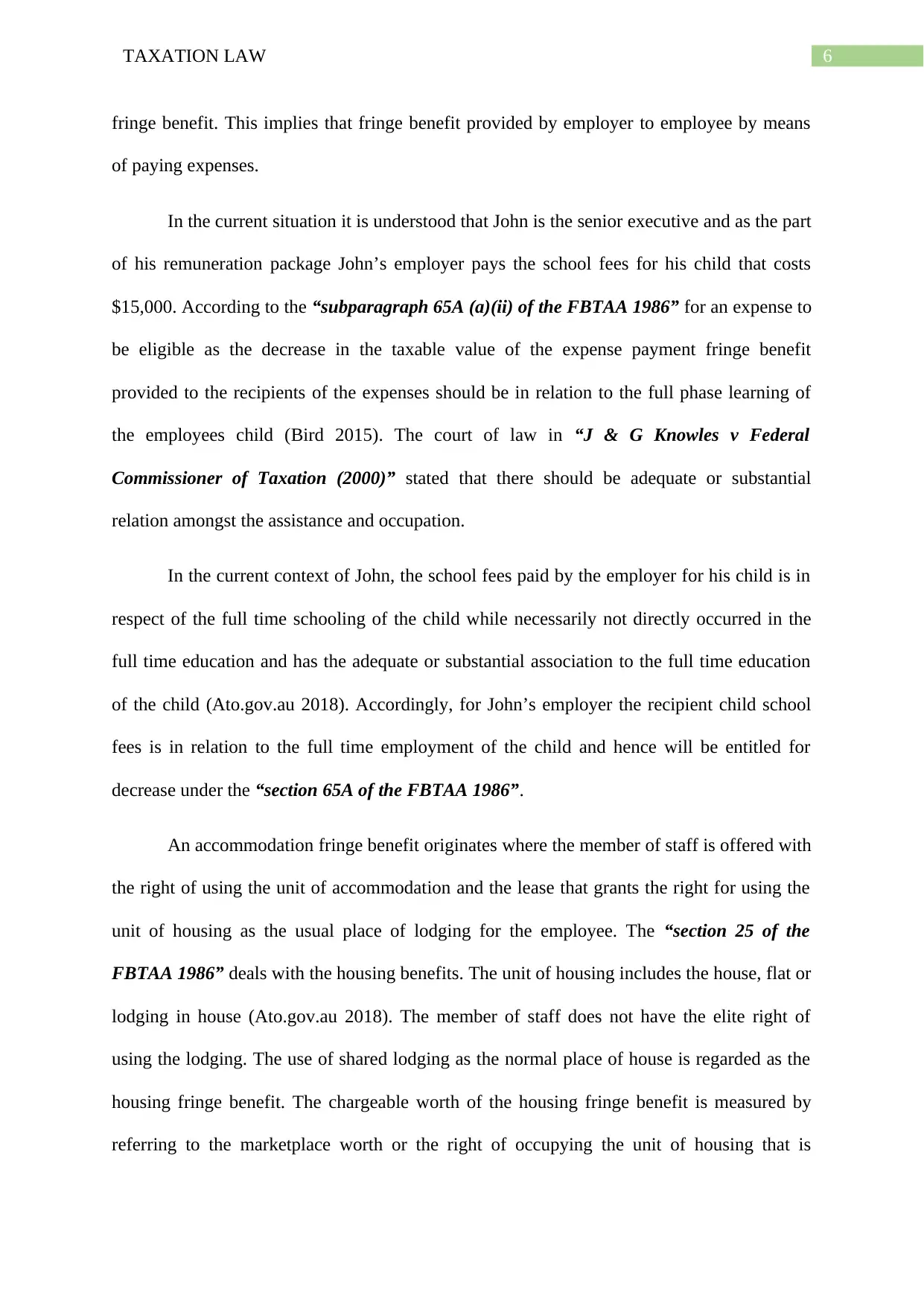
6TAXATION LAW
fringe benefit. This implies that fringe benefit provided by employer to employee by means
of paying expenses.
In the current situation it is understood that John is the senior executive and as the part
of his remuneration package John’s employer pays the school fees for his child that costs
$15,000. According to the “subparagraph 65A (a)(ii) of the FBTAA 1986” for an expense to
be eligible as the decrease in the taxable value of the expense payment fringe benefit
provided to the recipients of the expenses should be in relation to the full phase learning of
the employees child (Bird 2015). The court of law in “J & G Knowles v Federal
Commissioner of Taxation (2000)” stated that there should be adequate or substantial
relation amongst the assistance and occupation.
In the current context of John, the school fees paid by the employer for his child is in
respect of the full time schooling of the child while necessarily not directly occurred in the
full time education and has the adequate or substantial association to the full time education
of the child (Ato.gov.au 2018). Accordingly, for John’s employer the recipient child school
fees is in relation to the full time employment of the child and hence will be entitled for
decrease under the “section 65A of the FBTAA 1986”.
An accommodation fringe benefit originates where the member of staff is offered with
the right of using the unit of accommodation and the lease that grants the right for using the
unit of housing as the usual place of lodging for the employee. The “section 25 of the
FBTAA 1986” deals with the housing benefits. The unit of housing includes the house, flat or
lodging in house (Ato.gov.au 2018). The member of staff does not have the elite right of
using the lodging. The use of shared lodging as the normal place of house is regarded as the
housing fringe benefit. The chargeable worth of the housing fringe benefit is measured by
referring to the marketplace worth or the right of occupying the unit of housing that is
fringe benefit. This implies that fringe benefit provided by employer to employee by means
of paying expenses.
In the current situation it is understood that John is the senior executive and as the part
of his remuneration package John’s employer pays the school fees for his child that costs
$15,000. According to the “subparagraph 65A (a)(ii) of the FBTAA 1986” for an expense to
be eligible as the decrease in the taxable value of the expense payment fringe benefit
provided to the recipients of the expenses should be in relation to the full phase learning of
the employees child (Bird 2015). The court of law in “J & G Knowles v Federal
Commissioner of Taxation (2000)” stated that there should be adequate or substantial
relation amongst the assistance and occupation.
In the current context of John, the school fees paid by the employer for his child is in
respect of the full time schooling of the child while necessarily not directly occurred in the
full time education and has the adequate or substantial association to the full time education
of the child (Ato.gov.au 2018). Accordingly, for John’s employer the recipient child school
fees is in relation to the full time employment of the child and hence will be entitled for
decrease under the “section 65A of the FBTAA 1986”.
An accommodation fringe benefit originates where the member of staff is offered with
the right of using the unit of accommodation and the lease that grants the right for using the
unit of housing as the usual place of lodging for the employee. The “section 25 of the
FBTAA 1986” deals with the housing benefits. The unit of housing includes the house, flat or
lodging in house (Ato.gov.au 2018). The member of staff does not have the elite right of
using the lodging. The use of shared lodging as the normal place of house is regarded as the
housing fringe benefit. The chargeable worth of the housing fringe benefit is measured by
referring to the marketplace worth or the right of occupying the unit of housing that is
Paraphrase This Document
Need a fresh take? Get an instant paraphrase of this document with our AI Paraphraser
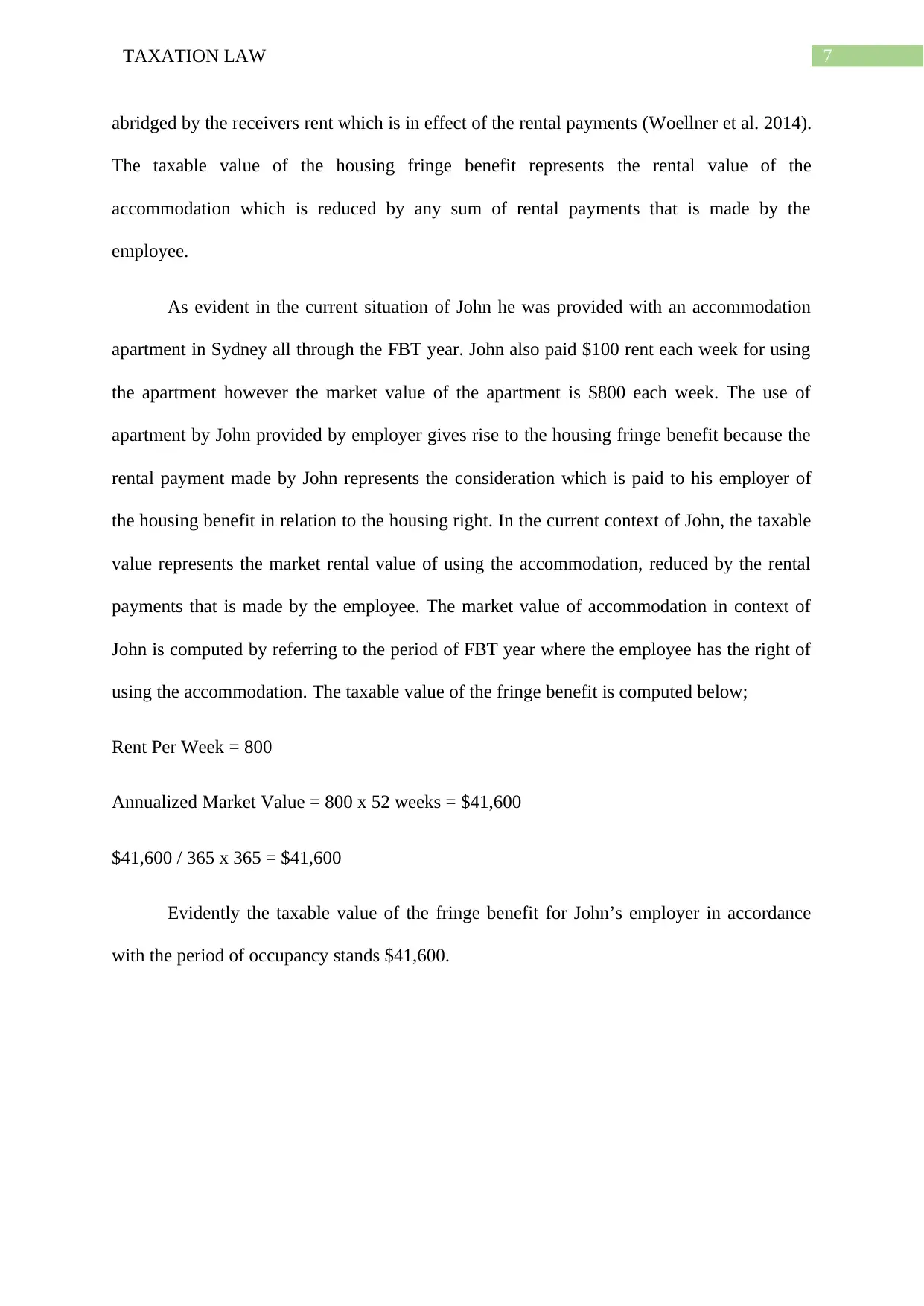
7TAXATION LAW
abridged by the receivers rent which is in effect of the rental payments (Woellner et al. 2014).
The taxable value of the housing fringe benefit represents the rental value of the
accommodation which is reduced by any sum of rental payments that is made by the
employee.
As evident in the current situation of John he was provided with an accommodation
apartment in Sydney all through the FBT year. John also paid $100 rent each week for using
the apartment however the market value of the apartment is $800 each week. The use of
apartment by John provided by employer gives rise to the housing fringe benefit because the
rental payment made by John represents the consideration which is paid to his employer of
the housing benefit in relation to the housing right. In the current context of John, the taxable
value represents the market rental value of using the accommodation, reduced by the rental
payments that is made by the employee. The market value of accommodation in context of
John is computed by referring to the period of FBT year where the employee has the right of
using the accommodation. The taxable value of the fringe benefit is computed below;
Rent Per Week = 800
Annualized Market Value = 800 x 52 weeks = $41,600
$41,600 / 365 x 365 = $41,600
Evidently the taxable value of the fringe benefit for John’s employer in accordance
with the period of occupancy stands $41,600.
abridged by the receivers rent which is in effect of the rental payments (Woellner et al. 2014).
The taxable value of the housing fringe benefit represents the rental value of the
accommodation which is reduced by any sum of rental payments that is made by the
employee.
As evident in the current situation of John he was provided with an accommodation
apartment in Sydney all through the FBT year. John also paid $100 rent each week for using
the apartment however the market value of the apartment is $800 each week. The use of
apartment by John provided by employer gives rise to the housing fringe benefit because the
rental payment made by John represents the consideration which is paid to his employer of
the housing benefit in relation to the housing right. In the current context of John, the taxable
value represents the market rental value of using the accommodation, reduced by the rental
payments that is made by the employee. The market value of accommodation in context of
John is computed by referring to the period of FBT year where the employee has the right of
using the accommodation. The taxable value of the fringe benefit is computed below;
Rent Per Week = 800
Annualized Market Value = 800 x 52 weeks = $41,600
$41,600 / 365 x 365 = $41,600
Evidently the taxable value of the fringe benefit for John’s employer in accordance
with the period of occupancy stands $41,600.
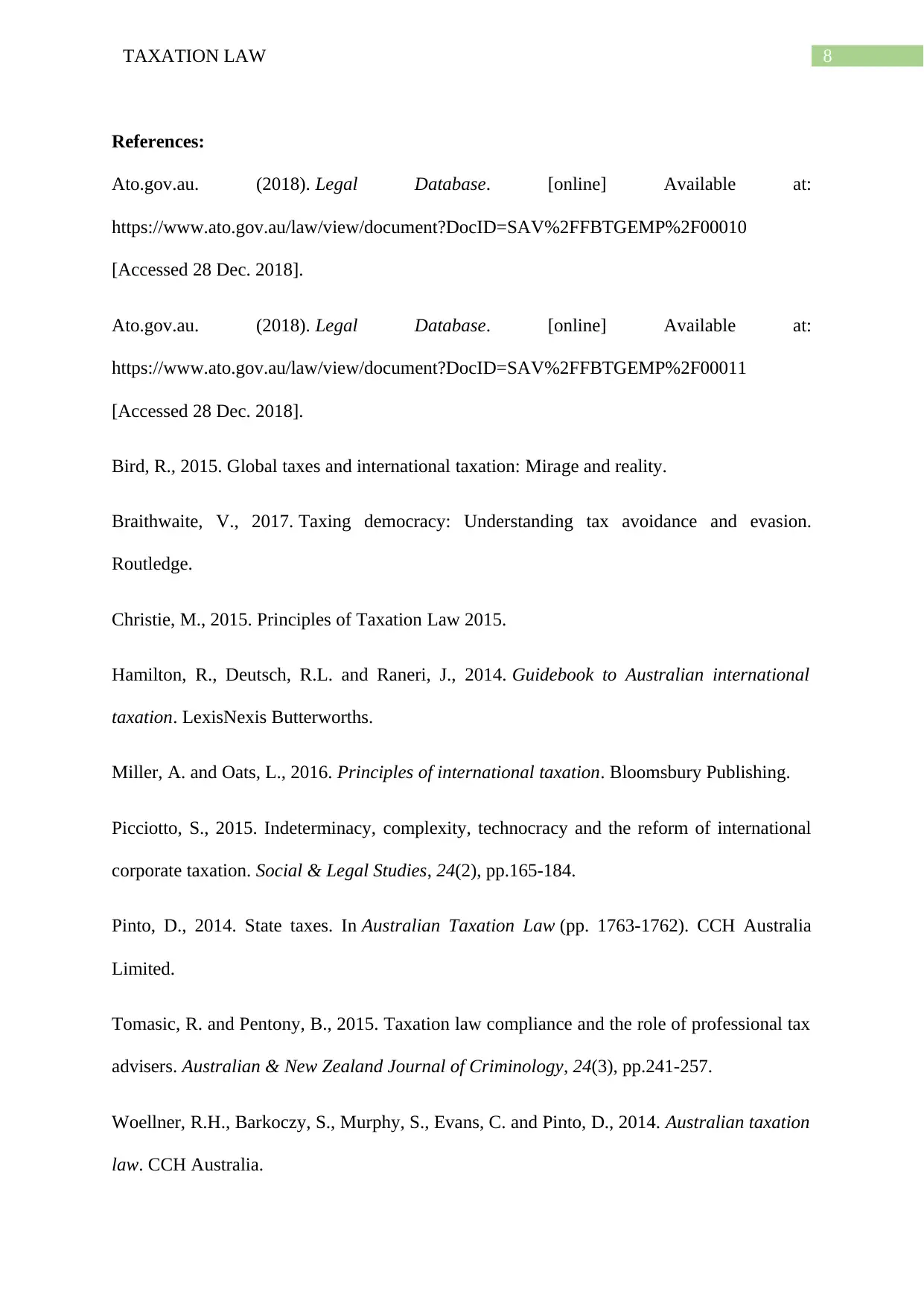
8TAXATION LAW
References:
Ato.gov.au. (2018). Legal Database. [online] Available at:
https://www.ato.gov.au/law/view/document?DocID=SAV%2FFBTGEMP%2F00010
[Accessed 28 Dec. 2018].
Ato.gov.au. (2018). Legal Database. [online] Available at:
https://www.ato.gov.au/law/view/document?DocID=SAV%2FFBTGEMP%2F00011
[Accessed 28 Dec. 2018].
Bird, R., 2015. Global taxes and international taxation: Mirage and reality.
Braithwaite, V., 2017. Taxing democracy: Understanding tax avoidance and evasion.
Routledge.
Christie, M., 2015. Principles of Taxation Law 2015.
Hamilton, R., Deutsch, R.L. and Raneri, J., 2014. Guidebook to Australian international
taxation. LexisNexis Butterworths.
Miller, A. and Oats, L., 2016. Principles of international taxation. Bloomsbury Publishing.
Picciotto, S., 2015. Indeterminacy, complexity, technocracy and the reform of international
corporate taxation. Social & Legal Studies, 24(2), pp.165-184.
Pinto, D., 2014. State taxes. In Australian Taxation Law (pp. 1763-1762). CCH Australia
Limited.
Tomasic, R. and Pentony, B., 2015. Taxation law compliance and the role of professional tax
advisers. Australian & New Zealand Journal of Criminology, 24(3), pp.241-257.
Woellner, R.H., Barkoczy, S., Murphy, S., Evans, C. and Pinto, D., 2014. Australian taxation
law. CCH Australia.
References:
Ato.gov.au. (2018). Legal Database. [online] Available at:
https://www.ato.gov.au/law/view/document?DocID=SAV%2FFBTGEMP%2F00010
[Accessed 28 Dec. 2018].
Ato.gov.au. (2018). Legal Database. [online] Available at:
https://www.ato.gov.au/law/view/document?DocID=SAV%2FFBTGEMP%2F00011
[Accessed 28 Dec. 2018].
Bird, R., 2015. Global taxes and international taxation: Mirage and reality.
Braithwaite, V., 2017. Taxing democracy: Understanding tax avoidance and evasion.
Routledge.
Christie, M., 2015. Principles of Taxation Law 2015.
Hamilton, R., Deutsch, R.L. and Raneri, J., 2014. Guidebook to Australian international
taxation. LexisNexis Butterworths.
Miller, A. and Oats, L., 2016. Principles of international taxation. Bloomsbury Publishing.
Picciotto, S., 2015. Indeterminacy, complexity, technocracy and the reform of international
corporate taxation. Social & Legal Studies, 24(2), pp.165-184.
Pinto, D., 2014. State taxes. In Australian Taxation Law (pp. 1763-1762). CCH Australia
Limited.
Tomasic, R. and Pentony, B., 2015. Taxation law compliance and the role of professional tax
advisers. Australian & New Zealand Journal of Criminology, 24(3), pp.241-257.
Woellner, R.H., Barkoczy, S., Murphy, S., Evans, C. and Pinto, D., 2014. Australian taxation
law. CCH Australia.
⊘ This is a preview!⊘
Do you want full access?
Subscribe today to unlock all pages.

Trusted by 1+ million students worldwide
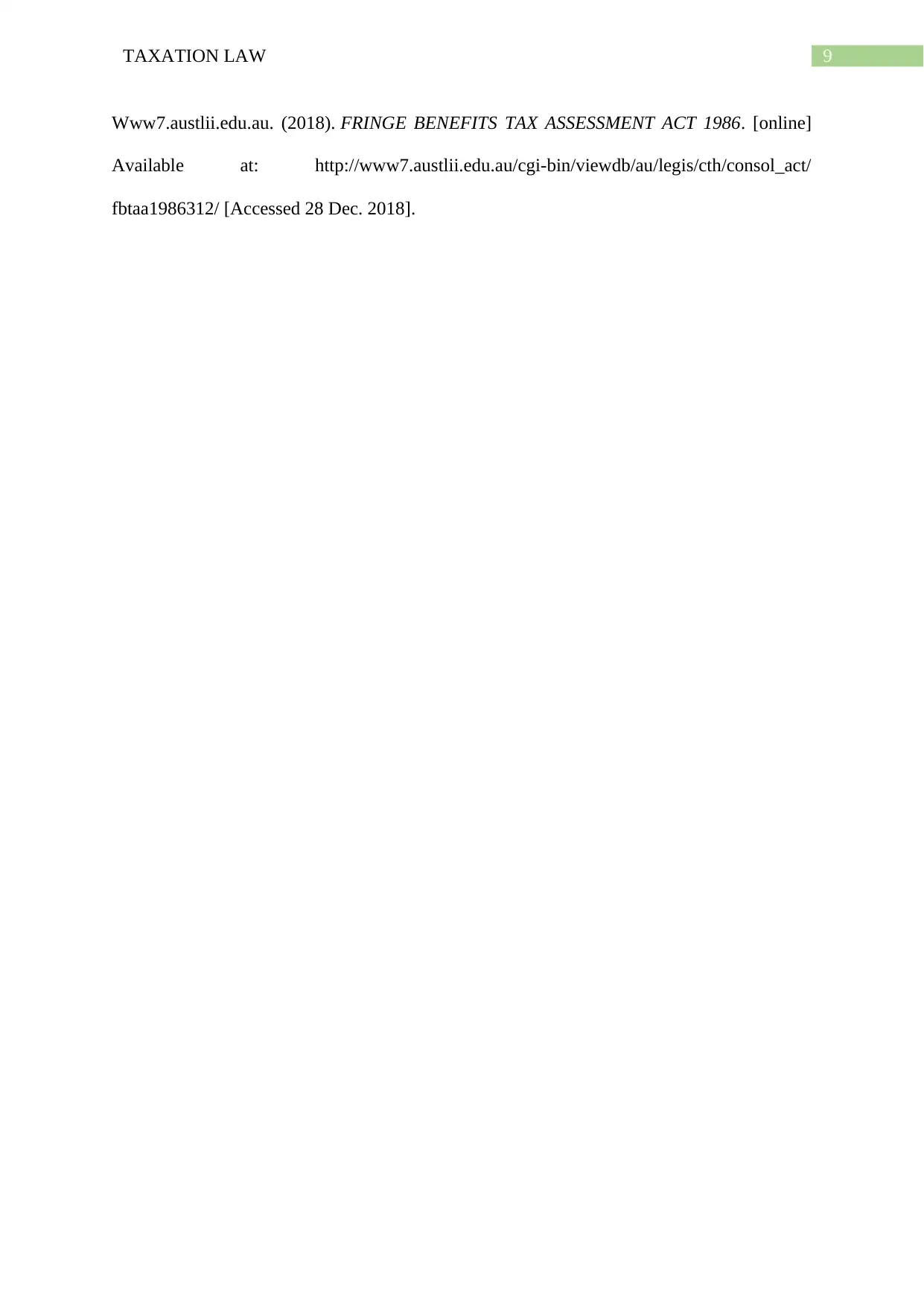
9TAXATION LAW
Www7.austlii.edu.au. (2018). FRINGE BENEFITS TAX ASSESSMENT ACT 1986. [online]
Available at: http://www7.austlii.edu.au/cgi-bin/viewdb/au/legis/cth/consol_act/
fbtaa1986312/ [Accessed 28 Dec. 2018].
Www7.austlii.edu.au. (2018). FRINGE BENEFITS TAX ASSESSMENT ACT 1986. [online]
Available at: http://www7.austlii.edu.au/cgi-bin/viewdb/au/legis/cth/consol_act/
fbtaa1986312/ [Accessed 28 Dec. 2018].
1 out of 10
Related Documents
Your All-in-One AI-Powered Toolkit for Academic Success.
+13062052269
info@desklib.com
Available 24*7 on WhatsApp / Email
![[object Object]](/_next/static/media/star-bottom.7253800d.svg)
Unlock your academic potential
Copyright © 2020–2025 A2Z Services. All Rights Reserved. Developed and managed by ZUCOL.





